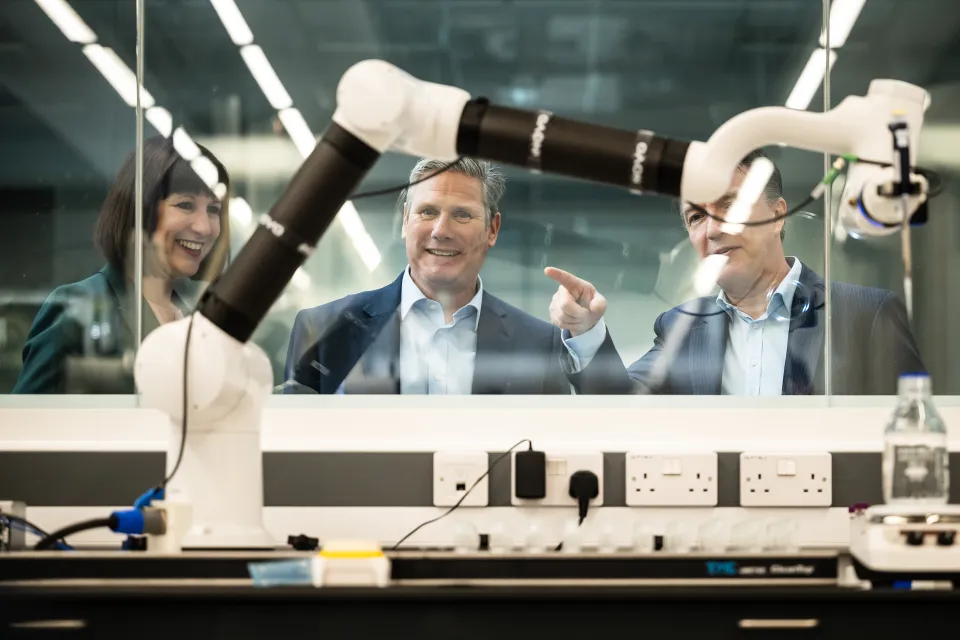What proportion of the civil service’s workload could AI handle today? What about in 10 years? Starmer could revolutionise Whitehall if he’s brave enough, writes Ed de Minckwitz
The recent announcement of a 15 per cent reduction in civil service spending, potentially affecting 10,000 to 15,000 roles, has been greeted with familiar reactions. For some, it is another swing of the austerity axe. For others, a necessary correction after a decade of bloat. But could it be the start of something else entirely? What if, rather than simply returning civil service headcount to pre-Covid baselines, this moment marked the first step towards something radically better: a civil service built for the age of superintelligence?
The Prime Minister recently offered a striking glimpse of that future: “No person’s substantive time should be spent on a task where digital or AI can do it better, quicker and to the same high quality and standard”. A striking line, but also a profound claim with sweeping implications. What proportion of the civil service’s current workload could AI handle today? What might that number be in five years? 10?

The civil service’s addition to accretion
The civil service was never designed for this kind of future. It has evolved by accretion, not reimagination. When confronted with a problem – a backlog, a surge in demand, a new policy priority – the default response is to hire more people. More case-handlers, more admin, more layers. In June 2016, the UK civil service employed 384,000 people. By December 2024, that number had ballooned to 514,000. Brexit and Covid-19 explain much of the growth, but they do not excuse the lack of reform. Departments like the Home Office, Cabinet Office, DfE, Defra and the Treasury have swelled. Yet while many commentators, and indeed many ministers, have pointed out that technology might offer a cheaper, faster, more sustainable solution, headcount has continued to rise.
During my time in government – as a special adviser to David Cameron and Theresa May, and chief of staff to Oliver Dowden as Deputy Prime Minister in the Cabinet Office – I saw this institutional reflex time and again. Operational expenditure on new people was easier to justify than capital expenditure on new systems. Promotions were dictated by the number of people managed, rather than the output attained. Digital transformation, when it came, was often slow, siloed and underpowered – more website upgrade than structural rethink.
But that cannot continue. Not if the UK wants to compete. Frontier AI experts are converging on a consensus that they will arrive at artificial general intelligence – models more capable than even the most expert humans in every cognitive endeavour – in the coming years, if not sooner. It is reasonable to assume that within five to 10 years interconnected superintelligent systems, capable of performing complex analytical tasks, interpreting vast datasets, drafting regulations, simulating policy outcomes and interfacing with citizens – will be deployed at scale.
Other governments are already using AI
In this age of superintelligence, global competitive advantage will not lie solely in innovation but in adoption. Countries that move fastest to integrate AI into their state machinery will leap ahead. Singapore has already launched gov.ai. Estonia has long been the poster child for digital government. The UAE appointed the world’s first minister for artificial intelligence in 2017. Denmark’s Agency for Digitisation has revolutionised citizen interactions with government, while Finland is pioneering AI literacy among its public servants. The UK has the capability to lead –- but not if it clings to 20th-century models of bureaucracy.
What would a superintelligent civil service look like? Less defined by headcount than by capability. One in which interdepartmental data systems actually speak to each other. Digital healthcare records would instantly inform benefit entitlements, while DWP systems would seamlessly access Home Office and HMRC data to ensure eligibility. Department for Education systems would automatically identify children eligible for free school meals or access health information for special educational needs assessments. AI Agents would do all but the most sensitive casework; fully-costed policy simulations could be run in minutes, not months. A recent study found that over 8m hours could be saved annually at DWP and HMRC alone by implementing today’s AI tools. That number would multiply dramatically with true integration between departmental systems and data.
Such a transformation requires more than software. It demands a cultural reset. Starmer’s rhetoric, if borne out by action, offers the beginnings of that. Combined with the new £3.25bn government Transformation Fund, the political will and investment now exist to make genuine progress. But Ministers will find themselves pushing against deep institutional habits. There is still a strong internal instinct to preserve what exists, to protect headcount, to view technology as a bolt-on rather than a redesign. Defenders of the status quo are today’s typing pool protesting the word processor.
AI could transform the civil service
Critics will argue that cutting staff now risks service collapse, that AI promises are overblown or that technology adoption requires more staff, not less. These objections miss the fundamental point: we are not discussing incremental change but transformative reinvention.
The question we should be asking is not: how do we get the civil service back to a manageable size? It is: what do we want it to become in 10 years? Then work backwards. A streamlined, technologically empowered public sector of 250,000 in 2030 could deliver far more, far better, than double that number today. The transition will require careful thought and management. Some functions will disappear entirely. Others will transform. New capabilities will emerge.
Civil servants themselves will need to evolve. The skills that made for effective government in the 20th century – drafting ability, procedural knowledge, careful case management – will be superseded by skills in data analysis, system design, ethical oversight of algorithms and managing the human-AI interface. Retraining, not just redundancy, must be part of the equation.
This is the lens through which civil service reform should now be viewed. The cuts announced this month should not be a return to some imagined status quo, but the beginning of a new chapter. A state apparatus designed not to resemble its past, but to anticipate its future.
This piece marks the start of a wider project I will be leading at Policy Exchange – Government in the Age of Superintelligence – to explore what this future could look like, from our institutions to our infrastructure. For now, it starts with a challenge: if the Prime Minister truly believes no one should spend their time on tasks AI can do better, quicker, and just as well, then the civil service must begin its journey from headcount to horsepower. Not smaller for its own sake, but smarter for all our sakes.
